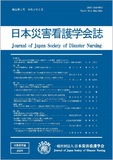Japanese
English
- 有料閲覧
- Abstract 文献概要
- 参考文献 Reference
要旨
目的:被災した女性の観点から、被災した女性が避難生活や生活再建における生活上の困難にどのように対応してきたのか、その体験を明らかにし、被災した女性への看護実践の示唆を得ることである。
方法:平成28年熊本地震で被災した成人女性6名を対象に半構造化面接を行い、得られた面接データをKJ法の手順に従って構造化した。
結果:最終ラベルのシンボルマークは6枚に集約された。それらの構造を検討した結果、被災した女性が体験した生活上の困難への対応とは、被災下で【助け合えるつながり】を支えに生活の【不自由さを凌ぐ】とともに【利他の心で助け合い】、【愉快さを忘れずに前進】した一方で、実のところ【体の悲鳴】が上がっていた体験を経て、【誰一人置き去りとならない地域の災害への備えが肝心の考えに至る】であった。
結論:KJ法による構造化により、被災した女性への看護実践において、平時から被災下で住民同士の助け合いや支え合いが生まれる共感力を高める防災活動や、被災下で女性の健康悪化を予防する支援が重要であることが示唆された。
Purpose: This study was aimed to clarify the experiences of disaster-affected Japanese women and how they responded to daily life difficulties during evacuation and reconstruction of their lives, and to obtain suggestions concerning nursing practice for them.
Method: Interview data collected from six women aged 20 to 60 years who were affected by the Kumamoto earthquake were analyzed using the KJ method
Results: The aggregated data were categorized into six final labels, and a symbol mark (a symbol representing one word) was added to each of these integrated final labels. Examining the data analysis structure revealed that, based on “Human connections for helping each other”, these women “Overcame inconveniences with daily life difficulties”, “Practiced altruism”, and “Moved forward positively without forgetting pleasantness”. However, “Fatigue and worsening health conditions” actually occurred in these women. Through this experience, the affected women “Reached the idea of disaster preparedness for the community whereby no one is left behind”.
Conclusion: Our findings suggest that residents should have the opportunity to participate in disaster prevention activities during non-disaster periods to enhance empathy so that they will help and support each other in the event of a disaster and thus to prevent deterioration of women's health under such circumstances.
Copyright © 2021, Japan Society of Disaster Nursing All rights reserved.


